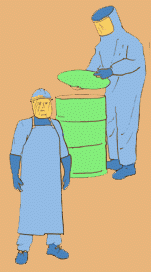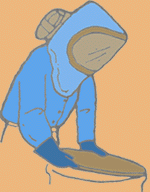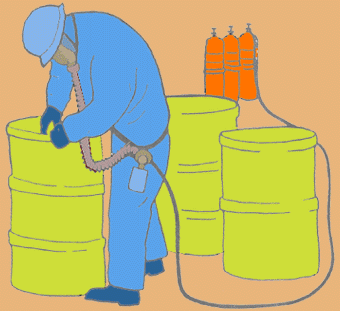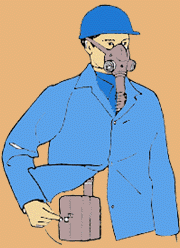
PERSONAL PROTECTIVE EQUIPMENT (PPE)
The purpose of personal protective clothing and equipment (PPE) is to shield or isolate individuals from the chemical, physical, and biologic hazards that may be encountered. Careful selection and use of adequate PPE should protect the respiratory system, skin, eyes, face, hands, feet, head, body, and hearing. No single combination of protective equipment and clothing is capable of protecting against all hazards. Thus PPE should be used in conjunction with other protective methods. The use of PPE can itself create significant worker hazards, such as heat stress, physical and psychological stress, and impaired vision, mobility, and communication. In general, the greater the level of PPE protection, the greater are the associated risks. For any given situation, equipment and clothing should be selected that provide an adequate level of protection. Overprotection as well as under-protection can be hazardous and should be avoided. Bear in mind that 85% of PPE failed to protect when studied in a recent survey of PPE effectiveness. As equipment ages, it may not work as well.
Use of PPE is required by Occupational Safety and Health Administration (OSHA) regulations in 29 CFR Part 1910 and reinforced by U.S. Environmental Protection Agency (EPA) regulations in 40 CFR Part 300. [Link to http://www.osha-slc.gov/OshStd_toc/OSHA_Std_toc_1910_SUBPART_I.html ]
NOTE: Employees must have medical clearance from a licensed physician to wear a respirator or personal protective equipment. The body incurs extra physical stress during the wearing of this protective equipment and it is important that employees be cleared by a licensed physician to undertake this additional stress. |
Chemical-protective clothing (CPC) is available in a variety of materials that offer a range of protection against different chemicals. The most appropriate clothing material will depend on the chemicals present and the task to be accomplished. Ideally, the chosen material resists permeation, degradation, and penetration. Permeation is the process by which a chemical dissolves in and/or moves through a protective clothing material on a molecular level. Degradation is the loss of or change in the fabric's chemical resistance or physical properties due to exposure to chemicals, use, or ambient conditions (e.g., sunlight). Penetration is the movement of chemicals through zippers, stitched seams or imperfections (e.g., pinholes) in a protective clothing material.
Selection of chemical-protective clothing is a complex task and should be performed by personnel with training and experience. Under all conditions, clothing is selected by evaluating the performance characteristics of the clothing against the requirements and limitations of the site- and task-specific conditions. If possible, representative garments should be inspected before purchase and their use and performance discussed with someone who has experience with the clothing under consideration. In all cases, the employer is responsible for ensuring that the personal protective clothing (and all PPE) necessary to protect employees from injury or illness that may result from exposure to hazards at the work site is adequate, and of safe design and construction for the work to be performed.

|
Respiratory protection is of primary importance since inhalation is one of the major routes of exposure to chemical toxicants. Respiratory protective devices (respirators) that are suited to atmospheres that are IDLH (Immediately Dangerous to Life or Health) or are likely to become IDLH consist of two types:
Air-purifying respirators (APRs), on the other hand, do not have a separate air source. Instead, they utilize ambient air which is "purified" through a filtering element prior to inhalation. Generally, these are of the negative pressure types. SCBAs, SARs, and air-purifying respirators are further differentiated by the type of air flow supplied to the facepiece: Positive-pressure respirators maintain a positive pressure in the facepiece during both inhalation and exhalation. The two main types of positive-pressure respirators are pressure-demand and continuous flow respirators. In pressure-demand respirators, a pressure regulator and an exhalation valve on the mask maintain the mask's positive pressure except during high breathing rates. If a leak develops in a pressure-demand respirator, the regulator sends a continuous flow of clean air into the facepiece, preventing penetration by contaminated ambient air. Continuous flow respirators (including some SARs and all powered air-purifying respirators [PAPRs] send a continuous stream of air into the facepiece at all times. With SARs, the continuous flow of air prevents infiltration by ambient air, but uses the air supply much more rapidly than with pressure-demand respirators. Powered air-purifying respirators [PAPRs] are operated in a positive-pressure continuous-flow mode utilizing filtered ambient air. (However, at maximal breathing rates, a negative pressure may be created in the facepiece of a PAPR.) Negative-pressure respirators draw air into the facepiece via the negative pressure created by user inhalation. The main disadvantage of negative-pressure respirators is that if any leaks develop in the system (i.e., a crack in the hose or an ill-fitting mask or facepiece), the user draws contaminated air into the facepiece during inhalation. Federal regulations require the use of respirators that have been tested and approved by MSHA and NIOSH. Testing procedures are described in 30 CFR Part 11. Approval numbers are clearly written on all approved respiratory equipment; however, not all respiratory equipment that is marketed is approved. Periodically, NIOSH publishes a list, entitled NIOSH Certified Equipment List of all approved respirators and respiratory components. |
| WEARING CONTACT LENSES WITH A RESPIRATOR IN A CONTAMINATED ATMOSPHERE IS PROHIBITED (29 CFR Part 1910.134. |
The level of protection that can be provided by a respirator is indicated by the respirator's protection factor. This number, which is determined experimentally by measuring facepiece seal and exhalation valve leakage, indicates the relative difference in concentrations of substances outside and inside the facepiece that can be maintained by the respirator. For example, the protection factor for full-facepiece air-purifying respirators is 50. This means, theoretically, that workers wearing these respirators should be protected in atmospheres containing chemicals at concentrations that are up to 50 times higher than the appropriate limits. One source of protection factors for various types of atmosphere-suppling (SCBA and SAR) and air-purifying respirators can be found in American National Standards Institute (ANSI) standard ANSI Z88.2-1980.
In situations where the identity and concentration of chemicals in air are known, a respirator should be selected with a protection factor that is sufficiently high to ensure that the wearer will not be exposed to the chemicals above the applicable limits. These limits include the American Conference of Governmental Industrial Hygienists' Threshold Limit Values (TLVs), OSHA's Permissible Exposure Limits (PELs), and the NIOSH Recommended Exposure Limits (RELs). These limits are designed to protect most workers who may be exposed to chemicals day after day throughout their working life. The OSHA PELs are legally enforceable exposure limits, and are the minimum limits of protection that must be met.
It should be remembered that the protection provided by a respirator can be compromised in several situations, most notably:
At high breathing rates, positive-pressure SCBAs and SARs may not maintain positive pressure for brief periods during peak inhalation. Also, at high work rates, exhalation valves may leak. Consequently, positive-pressure respirators working at high flow rates may offer less protection than when working at normal rates.
A similar reduction in protection may result from high or low ambient temperatures. For example, at high temperatures excessive sweat may cause a break in the face-to-facepiece seal. At very low temperatures, the exhalation valve and regulator may become ice-clogged due to moisture in the breath and air. Likewise, a poor facepiece seal - due to such factors as facial hair, missing teeth, scars, lack of or improper fit testing, etc. - can result in the penetration of air contaminants.
Self-Contained Breathing Apparatus (SCBA):
A self-contained breathing apparatus (SCBA) usually consists of a facepiece connected by a hose and
a regulator to an air source (compressed air, compressed oxygen, or an oxygen-generating
chemical) carried by the wearer. Only positive-pressure SCBAs are recommended for entry into
atmospheres that are immediately dangerous to life and health (IDLH).
SCBAs offer protection against most types levels of airborne contaminants. SCBAs are
limited by the amount of air carried and its rate of consumption. Also, SCBAs are
bulky and heavy, thus they increase the likelihood of heat stress and may impair movement in
confined spaces. Generally, only workers handling hazardous materials or operating in contaminated
zones require SCBAs.

Escape-only SCBAs are frequently continuous-flow devices with hoods that can be donned to provide immediate emergency protection. Employers should provide and ensure that employees carry an escape SCBA, or otherwise have immediate access to an escape SCBA, where such emergency protection may be necessary.
As required by MSHA/NIOSH 30 CFR Part 11.80, all compressed breathing gas cylinders must meet minimum U.S. Department of Transportation requirements for interstate shipment. (See also 49 CFR Parts 173 and 178.) All compressed air, compressed oxygen, liquid air, and liquid oxygen used for respiration shall be of high purity and must meet all requirements of OSHA 29 CFR Part 1910.134(d). In addition, breathing air must meet or exceed the requirements of Grade D breathing air as specified in the Compressed Gas Association pamphlet G-7.1 and ANSI Z86.11-1973.
Supplied-Air Respirators (SARs):
Supplied-air respirators (also known as air-line respirators) supply air, never oxygen, to a facepiece via a supply line from a stationary source. SARs are available in positive-pressure and negative-pressure modes. Pressure-demand SARs with escape provisions provide the highest level of protection (among SARs) and are the only SARs recommended for use at hazardous waste sites. SARs are not recommended for entry into IDLH atmospheres (MSHA/NIOSH 30 CFR Part 11) unless the apparatus is equipped with an escape SCBA.

The air source for supplied-air respirators may be compressed air cylinders or a compressor that purifies and delivers ambient air to the facepiece. SARs suitable for use with compressed air are classified as "Type C" supplied-air respirators as defined in MSHA/NIOSH 30 CFR Part 11. All SAR couplings must be incompatible with the outlets of other gas systems used on site to prevent a worker from connecting to an inappropriate compressed gas source (OSHA 29 CFR 1910.134[d]). [LINK to http://www.osha-slc.gov/OshStd_toc/OSHA_Std_toc_1910_SUBPART_I.html]
Air-Purifying Respirators:
Air-purifying respirators consist of a facepiece and an air-purifying device, which is either a removable component of the facepiece or an air-purifying apparatus worn on a body harness and attached to the facepiece by a corrugated breathing hose. Air-purifying respirators selectively remove specific airborne contaminants (particulates, gases, vapors, fumes) from ambient air by filtration, absorption, adsorption, or chemical reactions. They are approved for use in atmospheres containing specific chemicals up to designated concentrations, and not for IDLH atmospheres. Air-purifying respirators can be used only when the ambient atmosphere contains sufficient oxygen (19.5 percent) (30 CFR Part 1190[a]).
Conditions that may exclude use of air-purifying respirators:

|
Air-purifying respirators usually operate only in the negative-pressure mode except for powered air-purifying respirators (PAPRs) which maintain a positive facepiece pressure (except at maximal breathing rates). There are three types of air-purifying devices:
|
| IMPORTANT NOTE: Respirators must be fit-tested [Fit-tested means that the facepiece seals around the face so that during inhalation negative pressure is formed and air intake is only possible through the cartridge or air hoses]. Face shape and size can vary considerably throughout the human population, therefore it is important that the correct facepiece that fits that particular worker is found and passes the negative pressure test. For more common respirator masks with detachable cartridges, it is easy to fit-test by placing thumbs in the holes where the cartridges attach. In a proper fit-test the mask will cave in on the sides and breathing will become impossible. |
MSHA and NIOSH have granted approvals for manufacturers' specific assemblies of air-purifying respirators for a limited number of specific chemicals. Respirators should be used only for those substances for which they have been approved. Use of a sorbent shall not be allowed when there is reason to suspect that it does not provide adequate sorption efficiency against a specific contaminant. In addition, it should be noted that approval testing is performed at a given temperature and over a narrow range of flow rates and relative humidities; thus protection may be compromised in nonstandard conditions. The assembly that has been approved by MSHA and NIOSH to protect against organic vapors is tested against only a single challenge substance, carbon tetrachloride; its effectiveness for protecting against other vapors has not been demonstrated.
Most chemical sorbent canisters are imprinted with an expiration date. They may be used up to that date as long as they were not opened previously. Once opened, they begin to (ab)sorb humidity and air contaminants whether or not they are in use. Their efficiency and service life decreases and therefore they should be used immediately. Cartridges should be discarded after use but should not be used for longer than one shift or when breakthrough occurs, whichever comes first. Any cartridges that have been used for short durations only should be stored in a plastic bag to prevent sorption and contamination and should not be used longer than the total of one shift.
Where a canister or cartridge is being used against gases or vapors, the appropriate device shall be used only if the chemical(s) have "adequate warning properties" (30 CFR Part 11.150). NIOSH considers a substance to have adequate warning properties when its odor, taste, or irritant effects are detectable and persistent at concentrations below the Recommended Exposure Limit (REL). A substance is considered to have poor warning properties when its odor or irritation threshold is above the applicable exposure limit. Warning properties are essential to safe use of air-purifying respirators since they allow detection of contaminate breakthrough, should it occur. While warning properties are not foolproof, because they rely on human senses which vary widely among individuals and in the same individual under varying conditions (e.g., olfactory [sense of smell] fatigue), they do provide some indication of possible sorbent exhaustion, poor facepiece fit, or other malfunctions. OSHA permits the use of air-purifying respirators for protection against specific chemicals with poor warning properties provided that:
HEALTH AND FITNESS TO WEAR PPE:
| Training in PPE use is recommended and, for respirators, required by federal regulation in the OSHA standards in 29 CFR Part 1910 Subparts I and Z. |
[LINK to http://www.osha-slc.gov/OshStd_toc/OSHA_Std_toc_1910_SUBPART_I.html]
[LINK to http://www.osha-slc.gov/OshStd_toc/OSHA_Std_toc_1910_SUBPART_Z.html]
The training portion of the PPE program should delineate the user's responsibilities and explain the following, utilizing both classroom and field training when necessary:
Levels of PPE protection are delineated by the letters A, B, C and D. Level A is the most stringent and offers the highest available protection of respiratory, skin and eye protection. Level A is also the most difficult to function in. Overprotection is in itself a unnecessary hazard if adequate protection can be met with a lower level of protection. There is a tradeoff between protection level and work efficiency, however, employee safety should be the governing issue when the decision to choose protection levels is made. The following compares the different protection levels:
|
LEVEL OF PROTECTION | EQUIPMENT |
| A | RECOMMENDED:
OPTIONAL: Cooling unit, coveralls, Long cotton underwear, Hard hat, Disposable gloves and boot covers. |
| B | RECOMMENDED:
OPTIONAL: Coveralls, Disposable boot covers, Face shield, Long cotton underwear. |
| C | RECOMMENDED:
OPTIONAL: Coveralls, Disposable boot covers, Face shield, Long cotton underwear, ESCAPE MASK. |
| D | RECOMMENDED:
OPTIONAL: Gloves, Escape Mask, Face shield |
| LEVEL OF PROTECTION | PROTECTION PROVIDED |
| A | The highest available level of respiratory, skin and eye protection. However, fully-encapsulating suit material must be compatible with the substances involved. |
| B | The same level of respiratory protection but less skin protection than Level A. |
| C | The same level of skin protection as Level B, but a lower level of respiratory protection. |
| D | No respiratory protection. Minimal skin protection. |
| LEVEL OF PROTECTION | LEVEL OF PROTECTION TO USE WHEN: |
| A |
|
| B |
|
| C |
|
| D |
|
The discomfort and inconvenience of wearing PPE can create a resistance to the conscientious use of PPE. One essential aspect of training is to make the user aware of the need for PPE and to instill motivation for the proper use and maintenance of PPE.
[LINK to http://www.osha-slc.gov/OshStd_toc/OSHA_Std_toc_1910_SUBPART_I.html]